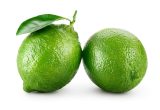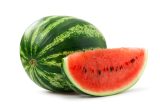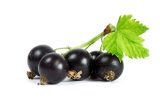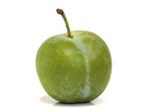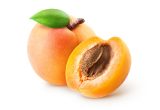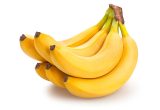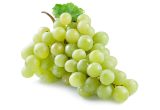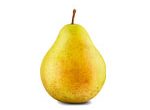Redcurrant

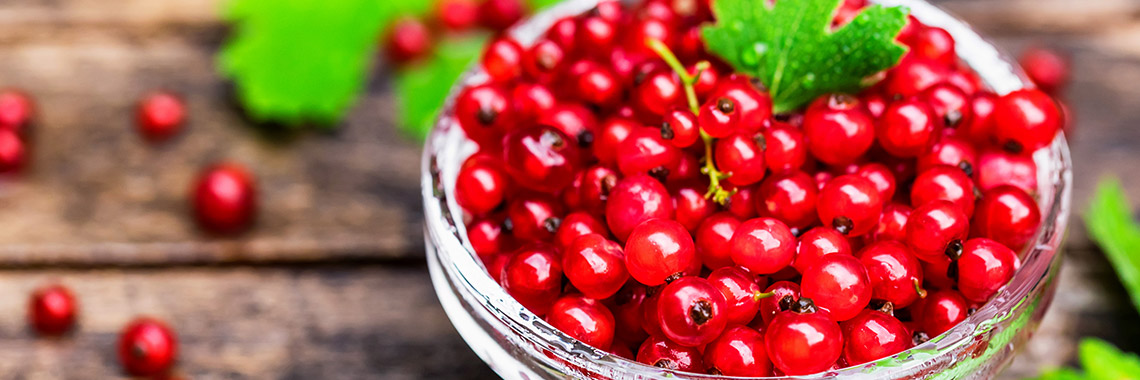
Description
- The redcurrant (Ribes rubrum) belongs to the Grossulariaceae family.
- It is a deciduous shrub native to Western Europe (Tomas, 2012).
PHYSICAL AND ORGANOLEPTIC CHARACTERISTICS
- Anthocyanin content, responsible for the red colour of the fruit, increases during the last three weeks of ripening and reaches a maximum of 890 mg/kg FW1. It also varies according to the cultivar (Zorenc, 2017).
- An important characteristic of the redcurrant is its ability to stay on the branches for a long time. Even after ripening, the berries do not fall off and often not only retain their flavour but improve due to the accumulation of sugars (Verzhuk, 2018).
COMPOSITION CHARACTERISTICS (excluding macronutrients, vitamins and minerals)
- These berries have been shown to reduce the incidence of several diseases such as hypertension, cardiovascular disease, osteoporosis, diabetes, cancer and inflammatory diseases (Frum, 2017).
- The most important health benefits of these berries are related to phenolic compounds (Kula, 2016).
- Redcurrant contains mostly phenolic compounds (>85%). Hydroxycinamic acid derivatives account for 1-6% and have also been detected in redcurrant (Gavrilova, 2011).
- Extracts obtained from two types of berries: redcurrant and raspberry, revealed the presence of phenolic compounds such as gallic acid, catechin, syringic acid, cinnamic acid, chlorogenic acid, ferulic acid, rutin and quercetin (Frum, 2017).
- Simultaneously, during the last three weeks of ripening, polyphenol content decreased slightly in red, pink and white cultivars, while the sugar/acid ratio increased. In white and pink cultivars, the reduction/absence of anthocyanins was mainly compensated by an increase in the relative concentrations of hydroxycinnamic acids and flavonols (Zorenc, 2017).
1 Fresh weight (FW) = fresh weight
RAW
The following values are approximate and depend on variety, season, ripeness, cultivation conditions, etc.
The redcurrant provides an average of 68.50 calories (kcal) per 100 g, i.e. 289 kJ.
A portion of redcurrants weighs on average 140 g, which represents about 95.90 kcal.
COMPOSITION TABLES
For each nutrient, the tables provide information on the content, minimum and maximum values, as well as the percentage of the Dietary Reference Values (DRVs) for 100 g net of redcurrants.
MACRONUTRIENTS
| Constituent (g) | Average content |
Min-Max per 100g |
DRV% |
|---|---|---|---|
| Water | 82,1 | 79,60 - 89,40 | - |
| Fibers | 4,60 | 3,40 - 4,90 | - |
| Carbohydrates | 7,06 | 3,86 - 9,20 | 2,72 |
| Sugars | 6,63 | NC - 7,37 | 7,37 |
| Lipids | 0,70 | 0,20 - 1,70 | 1 |
| Saturated fat | 0,21 | 0,017 - 0,38 | 1,05 |
| Protein | 1,56 | 0,10 - 1,88 | 3,12 |
| Constituent (g) | Amount | Min-Max | DRV% |
|---|---|---|---|
| Water | Ciqual 2020 | - | - |
| Fibers | Ciqual 2020 (valeur issue des analyses Ciqual-Aprifel 2018) | - | - |
| Carbohydrates | Ciqual 2020 | - | Règlement (UE) N°1169/2011 du parlement Européen et du conseil du 25 octobre 2011 |
| Sugars | Ciqual 2020 (valeur issue des analyses Ciqual-Aprifel 2018) | - | Règlement (UE) N°1169/2011 du parlement Européen et du conseil du 25 octobre 2011 |
| Lipids | Ciqual 2020 (valeur issue des analyses Ciqual-Aprifel 2018) | - | Règlement (UE) N°1169/2011 du parlement Européen et du conseil du 25 octobre 2011 |
| Saturated fat | Ciqual 2020 (valeur issue des analyses Ciqual-Aprifel 2018) | - | Règlement (UE) N°1169/2011 du parlement Européen et du conseil du 25 octobre 2011 |
| Protein | Ciqual 2020 (valeur issue des analyses Ciqual-Aprifel 2018) | - | Règlement (UE) N°1169/2011 du parlement Européen et du conseil du 25 octobre 2011 |
Zoom on carbohydrates
- The energy of the redcurrant comes mainly from its carbohydrates, at 7.06 g per 100 g.
- This amount is below the average content found in fresh fruit: about 11.31 g per 100 g.
- Its carbohydrates are mainly fructose (3.86 g per 100 g) and glucose (2.77 g per 100 g).
Focus on fibres
- The redcurrant is a source of fibre* as it contains more than 3 g of fibre per 100 g of fruit, i.e. 4.60 g per 100 g.
- It contains more than the average content found in fresh fruit (2.77 g per 100 g).
Focus on lipids
- Redcurrants are low in fat.
- The fat content of redcurrants (0.70 g per 100 g) is nevertheless higher than the average content of fresh fruit: 0.56 g per 100 g.
Zoom on proteins
- Redcurrants provide 1.56 g of protein per 100 g
*Regulation (EC) No 1924/2006 of the European Parliament and of the Council of 20 December 2006 on nutrition and health claims made on foods.
MINERALS AND TRACE ELEMENTS
| Constituent | Average content |
Min-Max per 100g |
DRV% |
|---|---|---|---|
| Calcium (mg) | 38 | 16,50 - 42 | 4,75 |
| Chloride (mg) | < 20 | - | - |
| Copper (mg) | 0,09 | 0,056 - 0,11 | 9 |
| Iron (mg) | 0,35 | NC - 1 | 2,50 |
| Iodine (µg) | < 20 | 0,80 - NC | - |
| Magnesium (mg) | 12 | 9,20 - 13,60 | 3,20 |
| Manganese (mg) | 0,13 | NC - 0,24 | 6,50 |
| Phosphorus (mg) | 38 | NC - 65,80 | 5,43 |
| Potassium (mg) | 230 | NC - 294 | 11,50 |
| Selenium (µg) | < 20 | 0 - NC | - |
| Sodium (mg) | < 5 | 1 - NC | - |
| Zinc (mg) | 0,15 | 0,13 - 0,27 | 1,50 |
| Constituent | Amount | Min-Max | DRV% |
|---|---|---|---|
| Calcium (mg) | Ciqual 2020 (valeur issue des analyses Ciqual-Aprifel 2018) | - | Règlement (UE) N°1169/2011 du parlement Européen, et du conseil du 25 octobre 2011 |
| Chloride (mg) | Ciqual 2020 (valeur issue des analyses Ciqual-Aprifel 2018) | - | Règlement (UE) N°1169/2011 du parlement Européen et du conseil du 25 octobre 2011 |
| Copper (mg) | Ciqual 2020 (valeur issue des analyses Ciqual-Aprifel 2018) | - | Règlement (UE) N°1169/2011 du parlement Européen et du conseil du 25 octobre 2011 |
| Iron (mg) | Ciqual 2020 (valeur issue des analyses Ciqual-Aprifel 2018) | - | Règlement (UE) N°1169/2011 du parlement Européen et du conseil du 25 octobre 2011 |
| Iodine (µg) | Ciqual 2020 (valeur issue des analyses Ciqual-Aprifel 2018) | - | Règlement (UE) N°1169/2011 du parlement Européen et du conseil du 25 octobre 2011 |
| Magnesium (mg) | Ciqual 2020 (valeur issue des analyses Ciqual-Aprifel 2018) | - | Règlement (UE) N°1169/2011 du parlement Européen et du conseil du 25 octobre 2011 |
| Manganese (mg) | Ciqual 2020 (valeur issue des analyses Ciqual-Aprifel 2018) | - | Règlement (UE) N°1169/2011 du parlement Européen et du conseil du 25 octobre 2011 |
| Phosphorus (mg) | Ciqual 2020 (valeur issue des analyses Ciqual-Aprifel 2018) | - | Règlement (UE) N°1169/2011 du parlement Européen et du conseil du 25 octobre 2011 |
| Potassium (mg) | Ciqual 2020 (valeur issue des analyses Ciqual-Aprifel 2018) | - | Règlement (UE) N°1169/2011 du parlement Européen et du conseil du 25 octobre 2011 |
| Selenium (µg) | Ciqual 2020 (valeur issue des analyses Ciqual-Aprifel 2018) | - | Règlement (UE) N°1169/2011 du parlement Européen et du conseil du 25 octobre 2011 |
| Sodium (mg) | Ciqual 2020 (valeur issue des analyses Ciqual-Aprifel 2018) | - | - |
| Zinc (mg) | Ciqual 2020 (valeur issue des analyses Ciqual-Aprifel 2018) | - | Règlement (UE) N°1169/2011 du parlement Européen et du conseil du 25 octobre 2011 |
Zoom on minerals and trace elements
- The redcurrant contains significant amounts of potassium and copper. In fact, it provides the equivalent of:
- 11.50% of DRVs for potassium, i.e. 230 mg per 100 g;
- 9% of DRVs for copper, i.e. 0.09 mg per 100 g.
- The other minerals and trace elements are present in quantities representing less than 7% of DRVs.
VITAMINS
| Constituent | Average content |
Min-Max per 100g |
DRV% |
|---|---|---|---|
| Provitamin A Beta-carotene (µg) | 25,60 | 25 - NC | - |
| Vitamin A equivalent (µg) | 4,26 | 4,16 - NC | 0,53 |
| Vitamin B1 (mg) | 0,041 | 0,019 - NC | 3,73 |
| Vitamin B2 (mg) | < 0,01 | NC - 0,05 | - |
| Vitamin B3 (mg) | 0,18 | 0,10 - 0,36 | 1,13 |
| Vitamin B5 (mg) | 0,65 | 0,064 - - | 10,83 |
| Vitamin B6 (mg) | 0,03 | 0,028 - 0,07 | 2,14 |
| Vitamin B9 (µg) | 11,80 | 8 - 26 | 5,90 |
| Vitamin C (mg) | 29,80 | 25 - 70 | 37,25 |
| Vitamin E (mg) | 1,19 | 0,10 - NC | 9,92 |
| Vitamin K1 (µg) | 2,06 | NC - 11 | 2,75 |
| Constituent | Amount | Min-Max | DRV% |
|---|---|---|---|
| Provitamin A Beta-carotene (µg) | Ciqual 2020 (valeur issue des analyses Ciqual-Aprifel 2018) | - | - |
| Vitamin A equivalent (µg) | Calcul à partir de la valeur Provitamine A Béta-carotène* | - | Règlement (UE) N°1169/2011 du parlement Européen et du conseil du 25 octobre 2011 |
| Vitamin B1 (mg) | Ciqual 2020 (valeur issue des analyses Ciqual-Aprifel 2018) | - | Règlement (UE) N°1169/2011 du parlement Européen et du conseil du 25 octobre 2011 |
| Vitamin B2 (mg) | Ciqual 2020 (valeur issue des analyses Ciqual-Aprifel 2018) | - | Règlement (UE) N°1169/2011 du parlement Européen et du conseil du 25 octobre 2011 |
| Vitamin B3 (mg) | Ciqual 2020 (valeur issue des analyses Ciqual-Aprifel 2018) | - | Règlement (UE) N°1169/2011 du parlement Européen et du conseil du 25 octobre 2011 |
| Vitamin B5 (mg) | Ciqual 2020 (valeur issue des analyses Ciqual-Aprifel 2018) | - | Règlement (UE) N°1169/2011 du parlement Européen et du conseil du 25 octobre 2011 |
| Vitamin B6 (mg) | Ciqual 2020 (valeur issue des analyses Ciqual-Aprifel 2018) | - | Règlement (UE) N°1169/2011 du parlement Européen et du conseil du 25 octobre 2011 |
| Vitamin B9 (µg) | Ciqual 2020 (valeur issue des analyses Ciqual-Aprifel 2018) | - | Règlement (UE) N°1169/2011 du parlement Européen et du conseil du 25 octobre 2011 |
| Vitamin C (mg) | Ciqual 2020 (valeur issue des analyses Ciqual-Aprifel 2018) | - | Règlement (UE) N°1169/2011 du parlement Européen et du conseil du 25 octobre 2011 |
| Vitamin E (mg) | Ciqual 2020 | - | Règlement (UE) N°1169/2011 du parlement Européen et du conseil du 25 octobre 2011 |
| Vitamin K1 (µg) | Ciqual 2020 (valeur issue des analyses Ciqual-Aprifel 2018) | - | Règlement (UE) N°1169/2011 du parlement Européen et du conseil du 25 octobre 2011 |
Zoom on vitamins
- The redcurrant is high in vitamin C, as it provides the equivalent of 37.25% of DRVs, i.e. 29.80 mg per 100 g.
- It also contains significant amounts of vitamin B5 and vitamin E. In fact, it provides the equivalent of:
- 10.83% of DRVs for vitamin B5, i.e. 0.65 mg per 100 g;
- 9.92% of DRVs for vitamin E, i.e. 1.19 mg per 100 g.
- The other vitamins are present in quantities representing less than 6% of DRVs.
*Calculation made: Beta Carotene / 6 + retinol
POLYPHENOLS
| Constituent (mg) | Average content |
Min-Max per 100mg |
|---|---|---|
| Flavonoids (mg) | 38,58 | 24,02 - 53,25 |
| of which Flavonols (mg) | 0,77 | 0,77 - 0,77 |
| of which Flavanols (mg) | 4,68 | 4,34 - 5,13 |
| of which Anthocyanins (mg) | 33,13 | 18,91 - 47,35 |
| Phenolic Acids (mg) | 3 | 1,95 - 4,38 |
| of which Hydroxybenzoic acids (mg) | 1,10 | 0,90 - 1,50 |
| of which Hydroxycinnamic acids (mg) | 1,90 | 1,05 - 2,88 |
| Stilbenes (mg) | 1,57 | 1,57 - 1,57 |
| Total polyphenols | 43,15 | 27,54 - 59,20 |
| Constituent (mg) | Amount | Min-Max |
|---|---|---|
| Flavonoids | Phenol explorer version 3.6 Méthode utilisée : Chromatographie | - |
| of which Flavonols | Phenol explorer version 3.6 Méthode utilisée : Chromatographie | - |
| of which Flavanols | Phenol explorer version 3.6 Méthode utilisée : Chromatographie | - |
| of which Anthocyanins | Phenol explorer version 3.6 Méthode utilisée : Chromatographie | - |
| Phenolic Acids | Phenol explorer version 3.6 Méthode utilisée : Chromatographie | - |
| of which Hydroxybenzoic acids | Phenol explorer version 3.6 Méthode utilisée : Chromatographie | - |
| of which Hydroxycinnamic acids | Phenol explorer version 3.6 Méthode utilisée : Chromatographie | - |
| Stilbenes | Phenol explorer version 3.6 Méthode utilisée : Chromatographie | - |
| Total polyphenols | Phenol explorer, version 3.6 Méthode utilisée : Chromatographie | - |
Zoom on polyphenols
- Polyphenols are substances with an antioxidant effect.
- The redcurrant has a notable quantity of polyphenols, 89% of which are flavonoids and in particular anthocyanins.
Nutrition and health claims
According to the definitions of nutrition claims as set out in Regulation (EC) No 1924/2006 on nutrition and health claims, and in view of the composition of redcurrants, the following claims may be used:
NUTRITION CLAIMS OF REDCURRANTS
- High in vitamin C (100 g of redcurrants provide the equivalent of more than 30% of DRVs)
- Source of fibre (100 g of redcurrants provide more than 3 g of fibre).
- Low in fat (100 g of redcurrants contain less than 3 g of fat)
HEALTH CLAIMS (for a consumption of 100 g of redcurrants)
Vitamin C
- Vitamin C contributes to:
- normal function of the immune system during and after intense physical exercise,
- normal collagen formation for the normal function of blood vessels,
- normal collagen formation for the normal function of bones,
- normal collagen formation for the normal function of cartilage,
- normal collagen formation for the normal function of gums,
- normal collagen formation for the normal function of skin,
- normal collagen formation for the normal function of teeth,
- normal energy-yielding metabolism,
- normal functioning of the nervous system,
- normal psychological function,
- normal function of the immune system,
- protection of cells from oxidative stress,
- reduction of tiredness and fatigue,
- regeneration of the reduced form of vitamin E.
- Vitamin C increases iron absorption.
References
-
Agence nationale de sécurité sanitaire de l’alimentation, de l’environnement et du travail. Table de composition nutritionnelle des aliments Ciqual 2020. Consultée le 17/08/2020 depuis le site internet Ciqual https://ciqual.anses.fr/
- Frum A, Georgescu C, Gligor F, Dobrea C, Tita O. Identification and Quantification of Phenolic Compounds from Red Currant (Ribes rubrum L.) and Raspberries (Rubus idaeus L.). International Journal of Pharmacology, Phytochemistry and Ethnomedicine. 2017;6:30-7.
- Gavrilova V, Kajdzanoska M, Gjamovski V, Stefova M. Separation, characterization and quantification of phenolic compounds in blueberries and red and black currants by HPLC-DAD-ESI-MSn. J Agric Food Chem. 2011;59(8):4009-18.
- Kula M. Phenolic composition of fruits from different cultivars of red and black raspberries grown in Poland, J. Food Comp. Anal. 2016;52:74-82.
- Règlement (CE) N° 1924/2006 du Parlement européen et du Conseil du 20 décembre 2006 concernant les allégations nutritionnelles et de santé portant sur les denrées alimentaires.
- Règlement (UE) N°432/2012 de la Commission du 16 mai 2012 établissant une liste des allégations de santé autorisées portant sur les denrées alimentaires, autres que celles faisant référence à la réduction du risque de maladie ainsi qu’au développement et à la santé infantiles.
- Règlement (UE) n°1169/2011 du Parlement européen et du Conseil du 25 octobre 2011 concernant l’information des consommateurs sur les denrées alimentaires, modifiant les règlements (CE) n°1924/2006 et (CE) n°1925/2006 du Parlement européen et de Conseil et abrogeant la directive 87/250/CEE de la Commission, la directive 90/496/CEE du Conseil, la directive 1999/10/CE de la Commission, la directive 200/13/CE du Parlement européen et du Conseil, les directives 2002/67/CE et 2008/5/CE de la Commission et le règlement (CE) n°608/2004 de la Commission.
- Tomás M, Alvarez-Perea A, Ledesma A, Baeza ML, de Barrio M. Allergy to red currant: immunoglobulin E-mediated hypersensitivity to lipid transport proteins (Pru p 3). J Investig Allergol Clin Immunol. 2012;22(2):140-1.
- Verzhuk VG, Pavlov AV, Sukhareva LV, Gracheva II, Kuvaeva TD. Development of methods for cryoconservation of vegetative shoots (cuttings) employing varieties of red currant (r. rubrum l.) from the gene pool preserved at the polar experiment station of the vavilov institute. 858-60.
- Zorenc Z, Veberic R, Koron D. Polyphenol metabolism in differently colored cultivars of red currant (Ribes rubrum L.) through fruit ripening. Planta. 2017;246:217-26.





